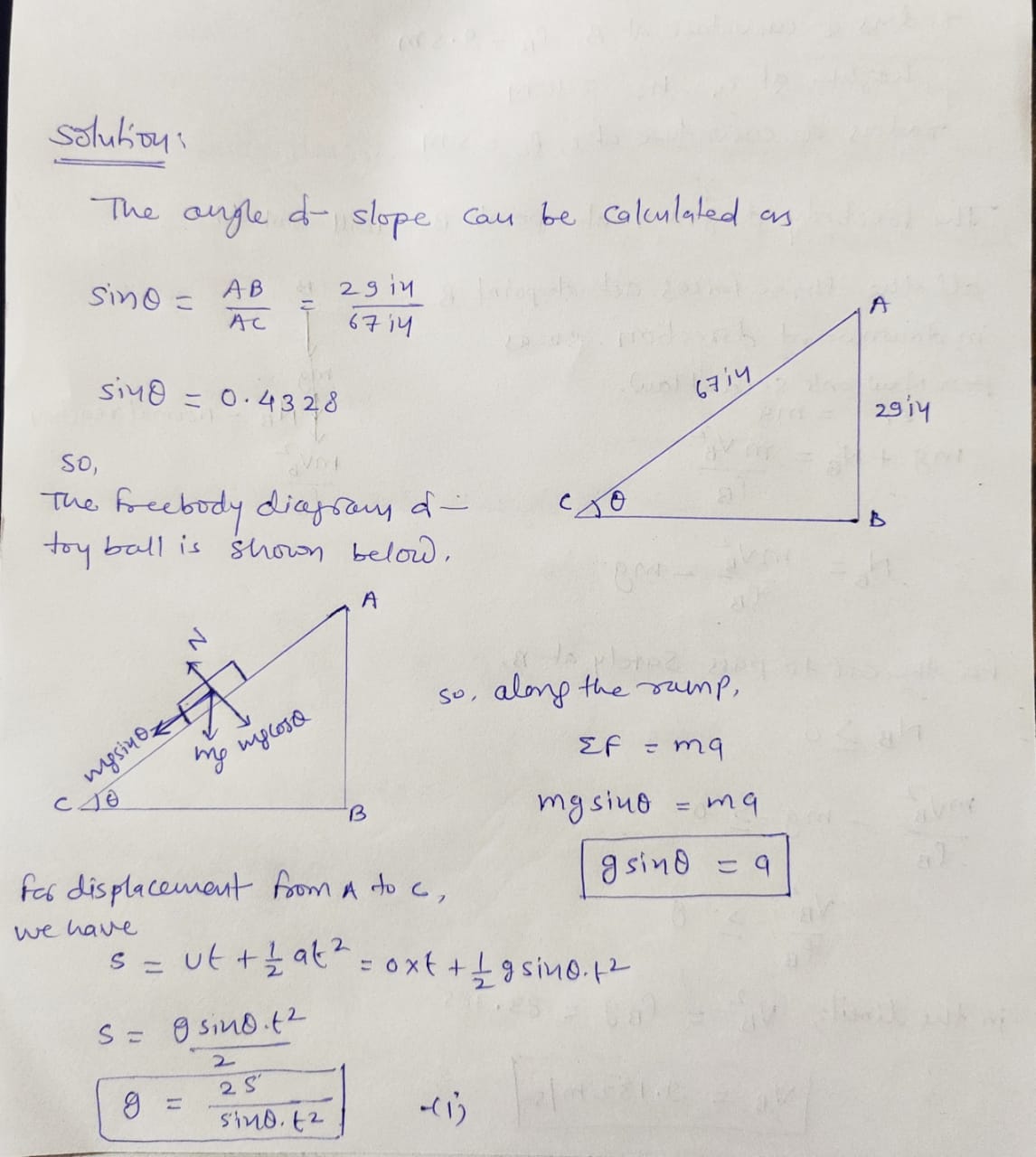Use the middle of the 5 measurements for your calculations. Use the equation: azgsim( a-g sin(e) to find the acceleration due to gravity. Off course you'll need the equations of kinematics to determine the acceleration "a" first before finding g. Again compare your result to the actual value of 9.80
Use the middle of the 5 measurements for your calculations. Use the equation: azgsim( a-g sin(e) to find the acceleration due to gravity. Off course you'll need the equations of kinematics to determine the acceleration "a" first before finding g. Again compare your result to the actual value of 9.80
Elements Of Electromagnetics
7th Edition
ISBN:9780190698614
Author:Sadiku, Matthew N. O.
Publisher:Sadiku, Matthew N. O.
ChapterMA: Math Assessment
Section: Chapter Questions
Problem 1.1MA
Related questions
Question
Please check if it’s correct
![Use the middle of the 5 measurements for your calculations. Use the equation:
\[ a = g \sin(\theta) \]
to find the acceleration due to gravity. Of course you'll need the equations of kinematics to determine the acceleration "a" first before finding \( g \). Again compare your result to the actual value of 9.80 m/sec\(^2\).
Then list 5 possible reasons why your result was different than the expected value.](/v2/_next/image?url=https%3A%2F%2Fcontent.bartleby.com%2Fqna-images%2Fquestion%2F560885b1-95a6-46a1-8479-9132da42c8bd%2F619a0bd6-3ad5-4e07-a786-5027053f92a5%2F0zbch_processed.jpeg&w=3840&q=75)
Transcribed Image Text:Use the middle of the 5 measurements for your calculations. Use the equation:
\[ a = g \sin(\theta) \]
to find the acceleration due to gravity. Of course you'll need the equations of kinematics to determine the acceleration "a" first before finding \( g \). Again compare your result to the actual value of 9.80 m/sec\(^2\).
Then list 5 possible reasons why your result was different than the expected value.

Transcribed Image Text:**Experiment #2**
In this section of the experiment, we will locate a smooth surface at an angle and measure the distance between the starting and finishing points of the hill. Then we'll place a ball at the top of the hill, let it go, and time how long it takes for the ball to roll down the hill, and repeat until we get 5 measurements total.
**Diagram and Calculations:**
1. **Triangle Setup:**
- Triangle ABC with:
- \( AB = 29 \text{ in} \)
- \( AC = 67 \text{ in} \)
- \(\sin \theta = \frac{AB}{AC} = \frac{29}{67} = 0.4328\)
- \(\theta = \sin^{-1}(0.4328) \approx 25.6^\circ\)
2. **Kinematic Equation:**
- Given:
- \(a = g \sin \theta\)
- \(u = 0\)
- Equation:
- \( s = ut + \frac{1}{2} at^2 \)
- \( s = \frac{1}{2} g \sin \theta t^2 \)
- \( g = \frac{2s}{\sin \theta t^2} \)
3. **Time of Top Going Down Hill:**
| Trial | Time (sec) |
|-------|------------|
| 1 | 0.80 sec |
| 2 | 0.60 sec |
| 3 | 0.74 sec |
| 4 | 0.46 sec |
| 5 | 0.66 sec |
4. **Average Time and Calculations:**
- Average time \( t = \frac{0.74 + 0.84 + 0.46 + 0.66}{5} = 0.5 \text{ sec} \)
- Distance \( s = 67 \text{ in} = 1.7018 \text{ m} \)
- \(\sin \theta = 0.4328\)
- \( g = \frac{s}{\sin \theta t^2} = \frac{2(1.7018)(0.5^2)}{
Expert Solution
Step 1

Step by step
Solved in 2 steps with 2 images

Recommended textbooks for you

Elements Of Electromagnetics
Mechanical Engineering
ISBN:
9780190698614
Author:
Sadiku, Matthew N. O.
Publisher:
Oxford University Press

Mechanics of Materials (10th Edition)
Mechanical Engineering
ISBN:
9780134319650
Author:
Russell C. Hibbeler
Publisher:
PEARSON

Thermodynamics: An Engineering Approach
Mechanical Engineering
ISBN:
9781259822674
Author:
Yunus A. Cengel Dr., Michael A. Boles
Publisher:
McGraw-Hill Education

Elements Of Electromagnetics
Mechanical Engineering
ISBN:
9780190698614
Author:
Sadiku, Matthew N. O.
Publisher:
Oxford University Press

Mechanics of Materials (10th Edition)
Mechanical Engineering
ISBN:
9780134319650
Author:
Russell C. Hibbeler
Publisher:
PEARSON

Thermodynamics: An Engineering Approach
Mechanical Engineering
ISBN:
9781259822674
Author:
Yunus A. Cengel Dr., Michael A. Boles
Publisher:
McGraw-Hill Education

Control Systems Engineering
Mechanical Engineering
ISBN:
9781118170519
Author:
Norman S. Nise
Publisher:
WILEY

Mechanics of Materials (MindTap Course List)
Mechanical Engineering
ISBN:
9781337093347
Author:
Barry J. Goodno, James M. Gere
Publisher:
Cengage Learning

Engineering Mechanics: Statics
Mechanical Engineering
ISBN:
9781118807330
Author:
James L. Meriam, L. G. Kraige, J. N. Bolton
Publisher:
WILEY